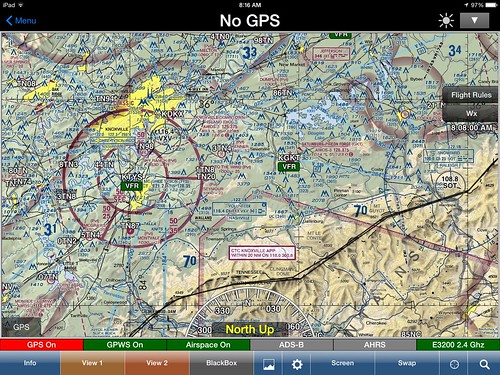darthnomster
Pre-takeoff checklist
- Joined
- Jun 6, 2011
- Messages
- 115
- Location
- Cincinnati, OH
- Display Name
Display name:
FlyLikeAGirl'sHubs
Tiffany and I took our longest cross country to date over the weekend. We flew from Butler County KHAO to Gatlinburg KGKT, had lunch then flew back. I flew down, she flew back. We're each approaching 100 hrs total time.
It was a safe/fun/successful flight, and we're both gaining confidence as we expand our envelopes. We continue to get more experience using flight following and getting our phraseology correct. We diverted to an airport enroute for a bathroom break, and were able to get all of the relevant info arrival info (runways, atis, ctaf) from the 430 without having to refer to the tablet or sectional. These kinds of small victories are fun.
One thing we continue to work on is holding altitude. In calm air, we're both pretty proficient at getting to cruise altitude, selecting the proper RPM power setting and leaning the airplane, and relieve the control pressures with elevator trim (she's better at this than I am) and it will stay there .
Where I feel like I'm constantly fiddling is when we hit thermals or fly over hills/mountains. I feel like I spend too much time looking at the altimeter, and not enough time with other parts of the scan. If I get my head out the window to look for traffic too long, I find myself glancing back to the altimeter to find I've climbed or descended 100 feet or more. I want to get better at this. We're on flight following, and as a courtesy to the controller, and in preparation for future IFR training, I want to be able to hold a damned altitude. Is this something where I need to talk to an instructor and get some tips/dual, or does this just get easier with experience?
It was a safe/fun/successful flight, and we're both gaining confidence as we expand our envelopes. We continue to get more experience using flight following and getting our phraseology correct. We diverted to an airport enroute for a bathroom break, and were able to get all of the relevant info arrival info (runways, atis, ctaf) from the 430 without having to refer to the tablet or sectional. These kinds of small victories are fun.
One thing we continue to work on is holding altitude. In calm air, we're both pretty proficient at getting to cruise altitude, selecting the proper RPM power setting and leaning the airplane, and relieve the control pressures with elevator trim (she's better at this than I am) and it will stay there .
Where I feel like I'm constantly fiddling is when we hit thermals or fly over hills/mountains. I feel like I spend too much time looking at the altimeter, and not enough time with other parts of the scan. If I get my head out the window to look for traffic too long, I find myself glancing back to the altimeter to find I've climbed or descended 100 feet or more. I want to get better at this. We're on flight following, and as a courtesy to the controller, and in preparation for future IFR training, I want to be able to hold a damned altitude. Is this something where I need to talk to an instructor and get some tips/dual, or does this just get easier with experience?

Last edited:


